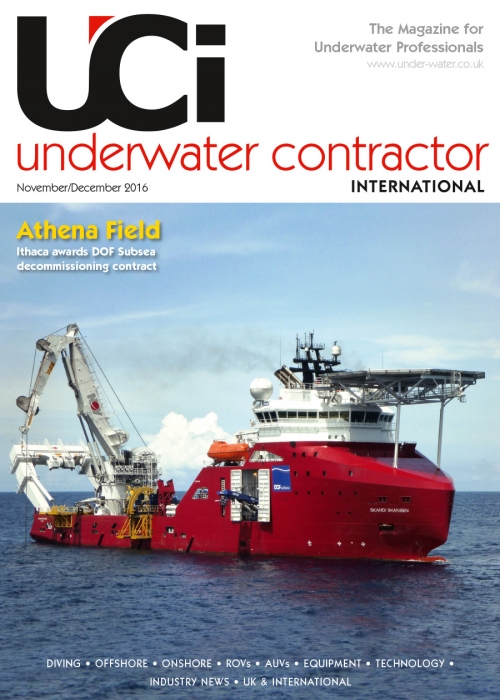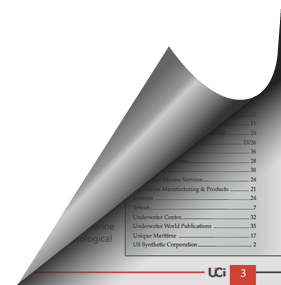
The Magazine for Underwater Professionals
![]() Nov/Dec 2015
Nov/Dec 2015
U/W VEHICLES
Hats off to the little guy
In a world where big is beautiful, it can be hard to see how a shoebox-sized ROV can compete with a massive 100hp work-class vehicle
The size of a van and with the effective power of a tractor, a typical work-class ROV is a formidable beast. With powerful hydraulic thrusters that can shrug-off the strongest currents and with seven-function manipulators that make light of the most complex tasks, it is hard to think of anything they cannot do.
Charlie Foll was, however, one person who could see their shortcomings, having spent years selling subsea equipment such as towed-arrays and subsea motion reference units.
“I saw an opportunity for small ROVs, so in 2001 I started Atlantas Marine. With a VideoRay ROV in the boot of my car, I toured the country demonstrating just how useful it could be,” he says. “It didn’t take long before other people were able to see the benefits of an underwater observation system that could be hand-carried, set up in minutes and all operated by one person.”
The first of Foll’s customers to spot the advantages of what was, fundamentally, little more than some extra eyes on a length of wire, used his VideoRay to plumb the depths of Lake Coniston in the English Lake District. The VideoRay enabled him to locate, in 37-metres of water, the scattered remains of Bluebird, the jet-propelled boat that gave Sir Donald Campbell the world water speed record but which flipped and took his life in 1967. For Foll’s customer, the VideoRay proved to be a fuss-free means of quickly getting a view more usually reserved for divers. It was as easy to operate as a radio-controlled toy car and it enabled him to explore whenever he wanted and for as long as he needed in order to locate the scattered fragments of the historic boat.
Foll’s second customer was Trinity House, UK, which had a more prosaic need to see below the surface whenever a ship sank in a navigation channel. The VideoRay system that Trinity House carried aboard its maintenance cutter was intended to plot the dimensions and status of the wreck but this was one job for which it proved unsuitable. At that time, the sonar and ultra-short baseline positioning technology that would make quick work of such a task today did not exist, so the work proved beyond the skill of its operators at that time.
INSPECT
Nevertheless, the ROV found a new vocation when it was used, among other things, to inspect the integrity of navigation buoy moorings. Quick and easy to deploy, it could provide immediate feedback and reveal whether there was a situation that made it necessary to send down a diver.
For Somerset, UK-based Atlantas Marine, sales of the VideoRay quickly took-off and the company was soon nominated as the US manufacturer’s best dealer, a title that it has regularly recouped. By this time Charlie Foll had realised that what most of his customers needed was the simple ability to see what was happening underwater without them needing to don a mask and wetsuit themselves. If a ship’s surveyor needs to identify a problem inside a tunnel thruster, a VideoRay lets him see it for himself. Although a diver might have extensive marine engineering knowledge and be able to deliver an eloquent description of the problem, there is no substitute for the surveyor seeing it for himself.
Seeing underwater is, of course, an elusive ability that can be obliterated by silt and poor conditions. Since those early days of Atlantas Marine, increasing numbers of tools have now been developed that can restore visual acuity and endow ROVs with vision that even goes beyond that of a diver.
All Atlantas VideoRay ROVs are now equipped with LYNN, Sweden, video enhancers which process the CCTV image in real-time to eliminate fog and correct contrast and colour balance to provide a much clearer view of the subject. When conditions deteriorate further, Teledyne BlueView, USA, 2D sonars can be used to cut through the darkness and provide a 130-degree swath of acoustic images of what lies up to 100 metres ahead. These devices are invariably used in conjunction with a Tritech, UK, MicroNav USBL positioning system that can create precise latitude/longitude references for underwater targets so that repeat visits to the same location are quick and simple.
Other tools available to clients today are dye detection systems for finding leaks in subsea structures, small manipulators, metal thickness measurement devices and others for cathodic protection assessment. Together, these add-up to a substantial inventory of equipment and Charlie Foll soon realised that Atlantas needed a larger ROV that was capable of carrying them.
The chosen vehicle was the Swedish-built Ocean Modules M500 V8 Sii which is substantially larger than the VideoRay and falls into the more recognisable category of an observation-class ROV. This electric-powered vehicle is unique in that, unlike other ROVs that fly suspended from their buoyancy, the Ocean Modules vehicle has its buoyancy located around its centre of gravity so that it gains the ability to rotate around it. With eight vectored thrusters, it gains six degrees of freedom and can consequently fly at any angle required. This endows it with the ability to scan up or down and to demonstrate a degree of acrobatic manoeuvrability that other ROVs cannot match.
MEASURE
This ability proved particularly useful when Atlantas Marine was commissioned to inspect the base of some wind turbine monopiles for signs of scouring. An effective technique for monitoring the rate of seabed erosion in these locations is to measure the angle at which the power delivery cable leaves the base of the monopile. The more erosion that has taken place will cause the seabed to be lower and the angle of the cable will consequently become steeper. It was found that measuring this angle was a simple task for the Ocean Modules ROV as it could simply land on the cable and its angle of rest be recorded to provide an accurate and repeatable measurement.
Despite the ROV’s obvious benefits, Atlantas Marine would stop short at claiming to be able to do the job of a diver. Although its ROVs can perform straightforward observation tasks and those requiring special technology in poor visibility or for long periods, much subsea work still needs the human touch. Under these circumstances the small ROV can become the diver’s partner by providing the surface team with eyes underwater so that the safety of the dive team can be monitored continuously.
A small ROV can also venture into confined spaces such as thruster tunnels and dangerous wrecks where a diver would be at serious risk. Even fish farm holding net inspections have proved to be hazardous for divers who can become entangled and is why this work is being increasingly assigned to ROVs.
Divers might also be asked to go into tanks of raw sewage but everyone is happier when this work can be allocated to an ROV. The same applies to work that ROVs of Atlantas Marine have performed for British Nuclear Fuels at Sellafield. No diver could enter the caustic and radioactive waters of the spent fuel storage tanks but the company’s ROVs have proved adept at the task and are regular visitors.
Having moved into more spacious premises in Yeovil, the Atlantas Marine business plan for 2016 is aimed at growth. The company now has larger workshop and repair facilities and with new technical and sales staff on the team it is planning to expand its maintenance, support and training services.
The company is also turning its attention to the commercial marine sector by offering its services to support marine surveyors and engineers. Professionals who need to examine a situation underwater can now use the company’s quick-reaction inspection service. With a team of freelance ROV pilots around the UK, Atlantas can call upon the nearest one available to undertake whatever inspection task is required. This enables surveyors to inspect, for example, an azimuth thruster, a damaged hull or inside a ballast tank with their own eyes.
PROVIDE
When sea conditions are more challenging, Atlantas Marine can provide the same survey service with its larger and more powerful Ocean Modules ROV. Atlantas ROV pilots are also adept at using the various tools and instruments that are available for use on VideoRay and Ocean Modules ROVs.
Potential clients may not be aware of what an ROV can do and this is why a tentative discussion with Atlantas can reveal solutions that the client had never envisaged. The company now hopes that the availability of the Atlantas Marine inspection services may become regarded as a highly practical new tool.
“Because we started-out as a sales company we have sold very many VideoRay ROVs because they are reasonably priced and easy for their owners to operate,” explains Charlie Foll. “Unfortunately it can still take a while for someone to learn how to use them with confidence in any situation. Strong currents can tax the pilot’s competence while underwater navigation can be a real challenge.”
He adds: “Finding something on the underside of a big ship and then returning to it quickly in poor visibility demands considerable practice. Someone such as a busy professional marine surveyor may not have the time to acquire that practice and buying a system for one’s own use is a major investment that may not be justified.
“This is why we believe that it can be more efficient to employ someone else who has that necessary expertise and is why we are now making our survey service readily and economically available.”


